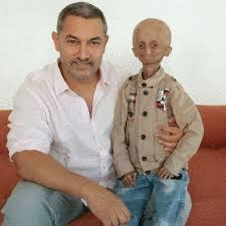
Signs of progeria include:
| • limited growth and short stature | • lack of body fat and muscle |  |
| • loss of hair, including eyelashes,eyebrows | • early signs of skin aging, including thin skin | |
| • stiffness in the joints | • visible veins | |
| • stroke | • narrow, wrinkled, or shrunken face | |
| • a head that is large compared with the body | • a small jaw bone | |
| • slow and abnormal tooth development | • a high-pitched voice | |
| • limited motion range, possible hip dislocation | • generalized atherosclerosis, leading to cardiovascular and heart disease |